九年级英语全册期末复习Unit 2 Great People单元语法复习课件
文档属性
| 名称 | 九年级英语全册期末复习Unit 2 Great People单元语法复习课件 |  | |
| 格式 | zip | ||
| 文件大小 | 101.6KB | ||
| 资源类型 | 教案 | ||
| 版本资源 | 冀教版 | ||
| 科目 | 英语 | ||
| 更新时间 | 2021-12-17 10:58:06 | ||
图片预览

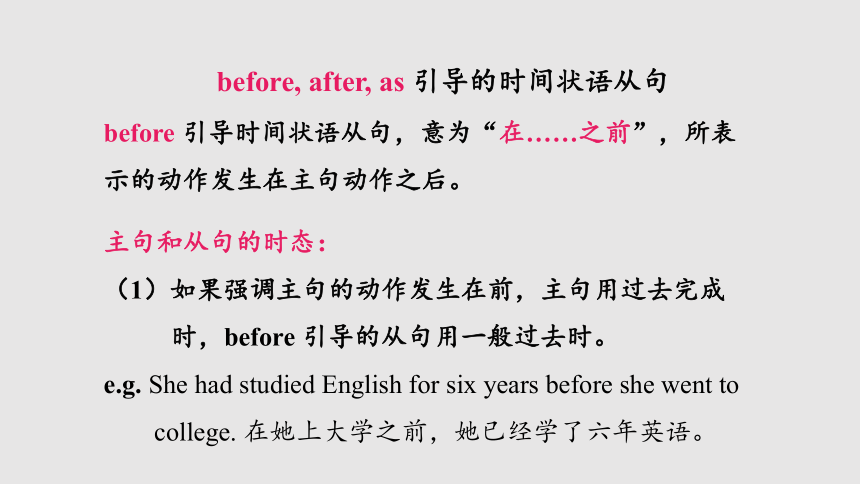
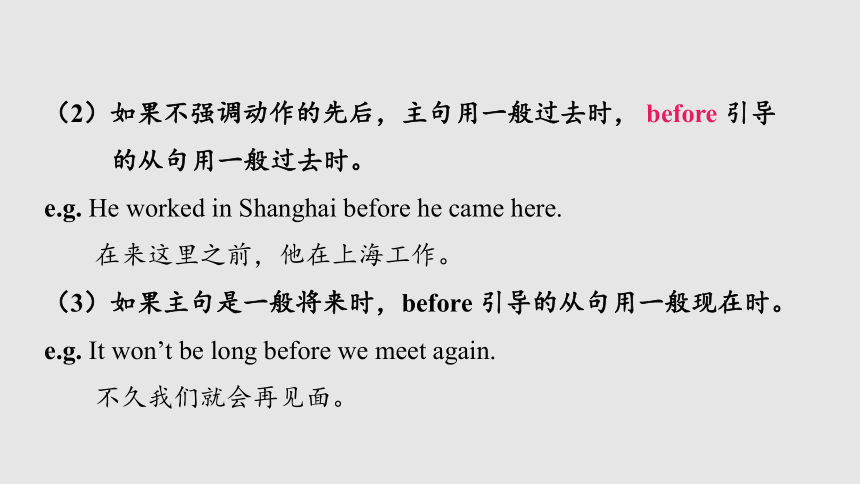
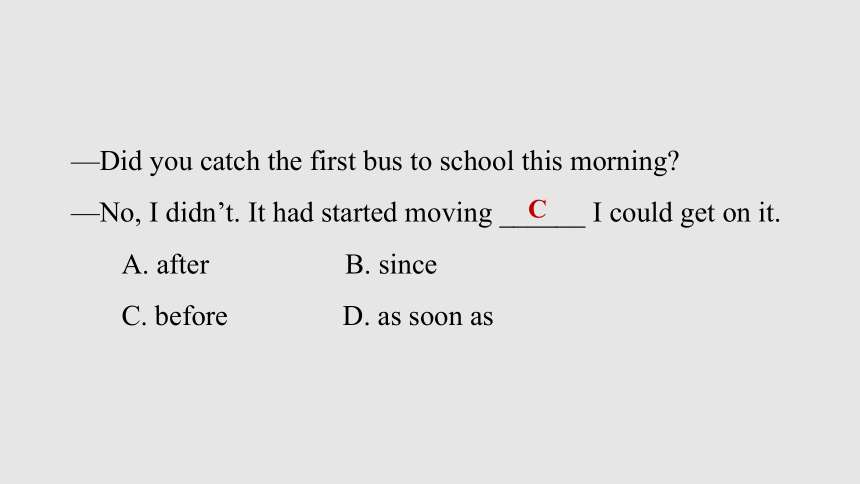

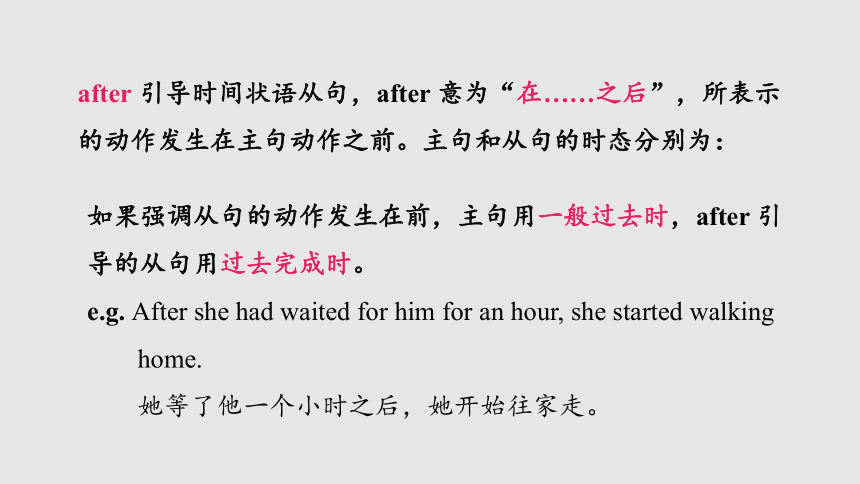
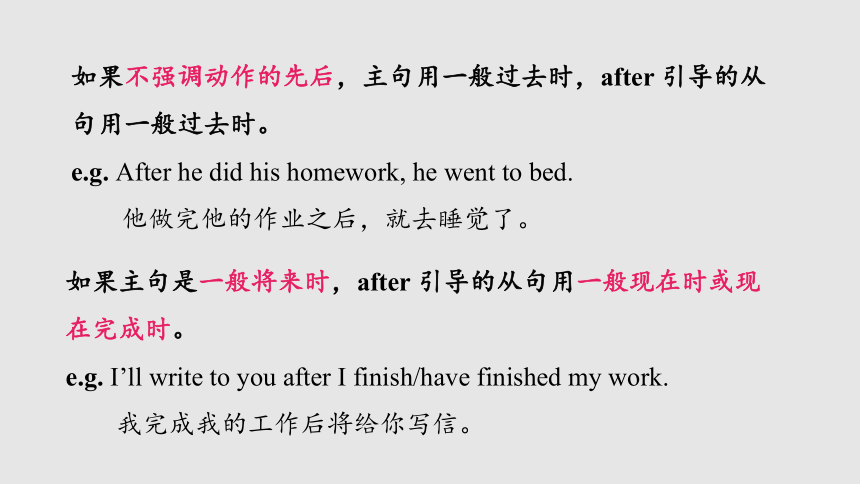
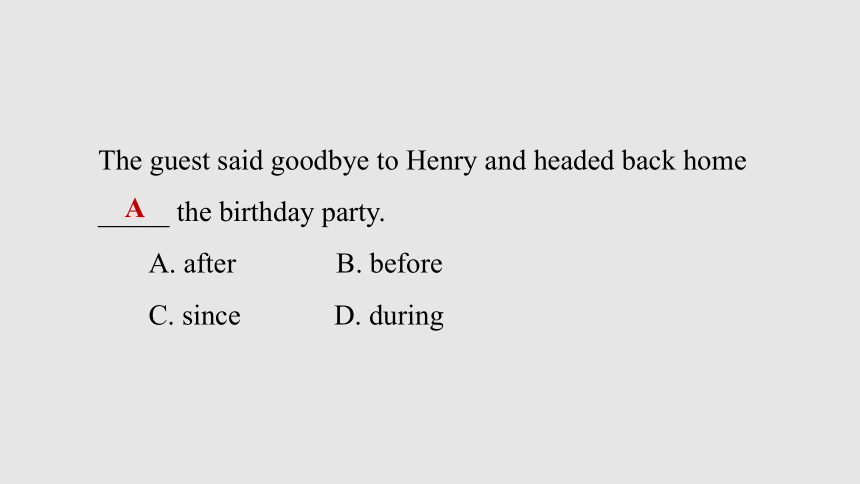
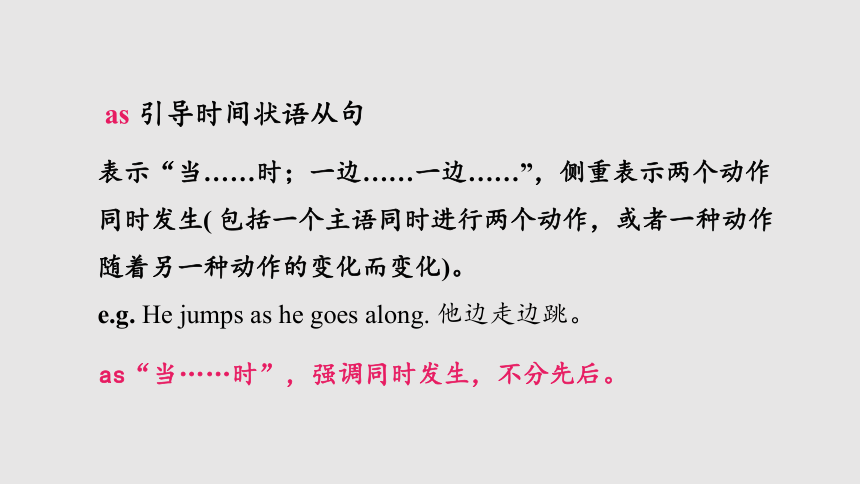
文档简介
(共25张PPT)
Unit 2 Great People
单元语法复习
2021--2022学年第一学期期末考试英语复习
before, after, as 引导的时间状语从句
before 引导时间状语从句,意为“在……之前”,所表示的动作发生在主句动作之后。
主句和从句的时态:
(1)如果强调主句的动作发生在前,主句用过去完成时,before 引导的从句用一般过去时。
e.g. She had studied English for six years before she went to college. 在她上大学之前,她已经学了六年英语。
(2)如果不强调动作的先后,主句用一般过去时, before 引导的从句用一般过去时。
e.g. He worked in Shanghai before he came here.
在来这里之前,他在上海工作。
(3)如果主句是一般将来时,before 引导的从句用一般现在时。
e.g. It won’t be long before we meet again.
不久我们就会再见面。
—Did you catch the first bus to school this morning
—No, I didn’t. It had started moving ______ I could get on it.
A. after B. since
C. before D. as soon as
C
主句和从句的位置:通常,时间状语从句位于主句前后均可。从句在前时,主从句之间必须用逗号隔开。
e.g. I’ll do it now before I forget it.
=Before I forget it, I’ll do it now.
趁还没有忘记,我这就把事情办了。
拓展:before 还可作副词,意为“从前,过去”。
e.g. I think we’ve met before. 我觉得我们以前见过面。
after 引导时间状语从句,after 意为“在……之后”,所表示的动作发生在主句动作之前。主句和从句的时态分别为:
如果强调从句的动作发生在前,主句用一般过去时,after 引导的从句用过去完成时。
e.g. After she had waited for him for an hour, she started walking home.
她等了他一个小时之后,她开始往家走。
如果不强调动作的先后,主句用一般过去时,after 引导的从句用一般过去时。
e.g. After he did his homework, he went to bed.
他做完他的作业之后,就去睡觉了。
如果主句是一般将来时,after 引导的从句用一般现在时或现在完成时。
e.g. I’ll write to you after I finish/have finished my work.
我完成我的工作后将给你写信。
The guest said goodbye to Henry and headed back home
_____ the birthday party.
A. after B. before
C. since D. during
A
as 引导时间状语从句
表示“当……时;一边……一边……”,侧重表示两个动作同时发生( 包括一个主语同时进行两个动作,或者一种动作随着另一种动作的变化而变化)。
e.g. He jumps as he goes along. 他边走边跳。
as“当……时”,强调同时发生,不分先后。
_____ the days went on, the weather got worse.
A. With B. Since
C. While D. As
D
who 和that 引导的定语从句
关系代词who
关系代词who 引导的定语从句修饰的先行词为人,在从句中作主语,此时who 不能省略。也可以作宾语。
e.g. Yesterday I helped an old man who lost his way.
昨天我帮助了一位迷路的老人。
—We teenagers should look up to the people ______ have made great achievements to our country, like Yuan Longping.
— I think so.
A. who B. what
C. which D. whose
A
Wang Yangming is a great educationalist ______
developed most of his thoughts in Xiuwen.
A. which B. what C. who
C
关系代词that
关系代词that 引导的定语从句的先行词可为人也可为物,在从句中作主语或宾语,作宾语时可省略。
e.g. The train that has just left is for Shenzhen.
刚刚离开的那辆火车是开往深圳的。
On Monday April 15, 2019, the fire _______ broke out in Notre Dame Cathedral in Paris shocked the world.
A. that
B. who
C. where
A
先行词是人时用that 的情况
①当关系代词在从句中作表语时用that。
e.g. She is not the woman that she used to be.
她已经不是过去的她了。
②避免重复或先行词中既有人又有物时。
e.g. Who is the girl that often comes to school early
常常早到校的那个女孩是谁?
I still remember the school and the teachers ______ I visited in Panzhihua years ago.
A. which B. that
C. who D. whom
B
一、单项选择
1. When some Chinese women were dancing to loud music in a park in New York, the people_____ lived nearby called the police.
A. who B. whom C. whose D. which
A
2.The boy _____is holding a ball is my brother.
A. what B. which
C. / D. who
D
3.—Did you catch the first bus to school this morning
— No, I didn’t. It had started moving_____ I could get on it.
A. after B. since
C. before D. as soon as
C
4.Tom opened the door and rushed out_____ I could stop him.
A. until B. after
C. unless D. before
D
5. —Who is your new English teacher
— Elena, the woman _____is wearing a red T-shirt over there.
A. who B. whom C. whose D. which
A
二、用as, before, after, when, as soon as 填空
The police asked the children not to cross the street _________ the traffic lights turned green.
Write to me ____________ you get to Beijing.
Kate fell into sleep _________ she was listening to the music.
before
as soon as
when
4. Daniel went to bed _________ he finished his homework last night.
5. _________ Helen grew older, she learned to read by herself.
after
As
Bye-bye!
Unit 2 Great People
单元语法复习
2021--2022学年第一学期期末考试英语复习
before, after, as 引导的时间状语从句
before 引导时间状语从句,意为“在……之前”,所表示的动作发生在主句动作之后。
主句和从句的时态:
(1)如果强调主句的动作发生在前,主句用过去完成时,before 引导的从句用一般过去时。
e.g. She had studied English for six years before she went to college. 在她上大学之前,她已经学了六年英语。
(2)如果不强调动作的先后,主句用一般过去时, before 引导的从句用一般过去时。
e.g. He worked in Shanghai before he came here.
在来这里之前,他在上海工作。
(3)如果主句是一般将来时,before 引导的从句用一般现在时。
e.g. It won’t be long before we meet again.
不久我们就会再见面。
—Did you catch the first bus to school this morning
—No, I didn’t. It had started moving ______ I could get on it.
A. after B. since
C. before D. as soon as
C
主句和从句的位置:通常,时间状语从句位于主句前后均可。从句在前时,主从句之间必须用逗号隔开。
e.g. I’ll do it now before I forget it.
=Before I forget it, I’ll do it now.
趁还没有忘记,我这就把事情办了。
拓展:before 还可作副词,意为“从前,过去”。
e.g. I think we’ve met before. 我觉得我们以前见过面。
after 引导时间状语从句,after 意为“在……之后”,所表示的动作发生在主句动作之前。主句和从句的时态分别为:
如果强调从句的动作发生在前,主句用一般过去时,after 引导的从句用过去完成时。
e.g. After she had waited for him for an hour, she started walking home.
她等了他一个小时之后,她开始往家走。
如果不强调动作的先后,主句用一般过去时,after 引导的从句用一般过去时。
e.g. After he did his homework, he went to bed.
他做完他的作业之后,就去睡觉了。
如果主句是一般将来时,after 引导的从句用一般现在时或现在完成时。
e.g. I’ll write to you after I finish/have finished my work.
我完成我的工作后将给你写信。
The guest said goodbye to Henry and headed back home
_____ the birthday party.
A. after B. before
C. since D. during
A
as 引导时间状语从句
表示“当……时;一边……一边……”,侧重表示两个动作同时发生( 包括一个主语同时进行两个动作,或者一种动作随着另一种动作的变化而变化)。
e.g. He jumps as he goes along. 他边走边跳。
as“当……时”,强调同时发生,不分先后。
_____ the days went on, the weather got worse.
A. With B. Since
C. While D. As
D
who 和that 引导的定语从句
关系代词who
关系代词who 引导的定语从句修饰的先行词为人,在从句中作主语,此时who 不能省略。也可以作宾语。
e.g. Yesterday I helped an old man who lost his way.
昨天我帮助了一位迷路的老人。
—We teenagers should look up to the people ______ have made great achievements to our country, like Yuan Longping.
— I think so.
A. who B. what
C. which D. whose
A
Wang Yangming is a great educationalist ______
developed most of his thoughts in Xiuwen.
A. which B. what C. who
C
关系代词that
关系代词that 引导的定语从句的先行词可为人也可为物,在从句中作主语或宾语,作宾语时可省略。
e.g. The train that has just left is for Shenzhen.
刚刚离开的那辆火车是开往深圳的。
On Monday April 15, 2019, the fire _______ broke out in Notre Dame Cathedral in Paris shocked the world.
A. that
B. who
C. where
A
先行词是人时用that 的情况
①当关系代词在从句中作表语时用that。
e.g. She is not the woman that she used to be.
她已经不是过去的她了。
②避免重复或先行词中既有人又有物时。
e.g. Who is the girl that often comes to school early
常常早到校的那个女孩是谁?
I still remember the school and the teachers ______ I visited in Panzhihua years ago.
A. which B. that
C. who D. whom
B
一、单项选择
1. When some Chinese women were dancing to loud music in a park in New York, the people_____ lived nearby called the police.
A. who B. whom C. whose D. which
A
2.The boy _____is holding a ball is my brother.
A. what B. which
C. / D. who
D
3.—Did you catch the first bus to school this morning
— No, I didn’t. It had started moving_____ I could get on it.
A. after B. since
C. before D. as soon as
C
4.Tom opened the door and rushed out_____ I could stop him.
A. until B. after
C. unless D. before
D
5. —Who is your new English teacher
— Elena, the woman _____is wearing a red T-shirt over there.
A. who B. whom C. whose D. which
A
二、用as, before, after, when, as soon as 填空
The police asked the children not to cross the street _________ the traffic lights turned green.
Write to me ____________ you get to Beijing.
Kate fell into sleep _________ she was listening to the music.
before
as soon as
when
4. Daniel went to bed _________ he finished his homework last night.
5. _________ Helen grew older, she learned to read by herself.
after
As
Bye-bye!
同课章节目录
